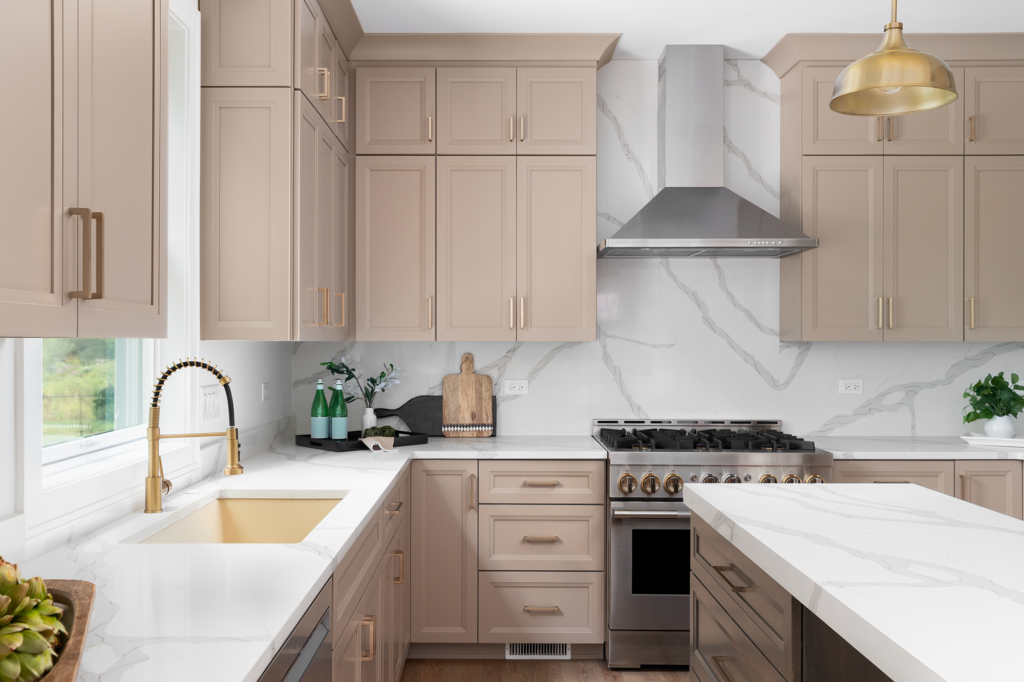The Pros and Cons of Full-Slab Backsplashes: Is It the Right Choice for Your Kitchen?
The backsplash is crucial in terms of functionality and aesthetics when designing a kitchen. While traditional tile backsplashes have long been the standard, many homeowners are now opting for full-slab backsplashes—a single, continuous piece of granite, quartz, or marble that extends from the countertop to the cabinets.
This modern design choice offers a sleek, high-end look but has its own considerations. In this guide, we’ll break down the pros and cons of full-slab backsplashes to help you decide if they’re right for your kitchen.
What Is a Full-Slab Backsplash?
A full-slab backsplash is a seamless extension of stone, quartz, or porcelain that covers the wall space behind countertops. Unlike traditional tile backsplashes, which have grout lines, full-slab backsplashes create a clean, continuous surface that enhances the visual flow of the kitchen.
Common materials used for full-slab backsplashes include:
- Granite – Durable and heat-resistant, offering a natural stone aesthetic.
- Quartz – non-porous, low maintenance, and available in various colors and patterns.
- Marble – Elegant and timeless, though more prone to staining and etching.
- Porcelain Slabs – Lightweight, heat-resistant, and available in ultra-thin formats for a modern look.
Pros of Full-Slab Backsplashes
- Seamless and Luxurious Look: A full-slab backsplash offers a high-end, streamlined appearance that enhances the beauty of the kitchen. The continuous stone creates a sleek, modern, and luxurious feel, elevating the space in a way that tile backsplashes often can’t.
- Easy to Clean and Maintain: One of the most significant advantages of full-slab backsplashes is the lack of grout lines. Tile backsplashes often require frequent scrubbing to remove dirt and grime from grout. With a slab backsplash, cleaning is as simple as wiping the surface with a damp cloth and mild cleaner.
- Unique and Natural Beauty: Since full slabs showcase natural veining and patterns, they add a one-of-a-kind element to your kitchen. Whether you choose dramatic marble veining, classic granite patterns, or modern quartz designs, no two full-slab backsplashes are alike.
- Increased Home Value: A full-slab backsplash is a high-end design feature that can boost your home’s resale value. Homebuyers often see this as a luxury upgrade, making it an excellent investment for long-term property value.
- Durable and Long-Lasting: Full slabs are incredibly durable, unlike tile, which can crack or have grout discoloration over time. Granite, quartz, and marble backsplashes are built to withstand heat, moisture, and daily wear, making them a long-lasting option for any kitchen.
Cons of Full-Slab Backsplashes
- Higher Cost: One of the most significant drawbacks of a full-slab backsplash is the price. Because a large, continuous slab requires more material and precise fabrication, it costs significantly more than a tile backsplash. Pricing varies depending on the material, with marble and exotic granite being the most expensive.
- Requires Professional Installation: Unlike tile backsplashes, which can sometimes be a DIY project, full-slab backsplashes require professional measurement, cutting, and installation. The heavy weight of natural stone or quartz also means you’ll need expert handling to avoid breakage.
- Limited Repair Options: If a full-slab backsplash gets chipped, scratched, or cracked, repairs can be more challenging than replacing a few damaged tiles. While stone repair kits can fix minor damage, significant cracks may require replacing the entire slab.
- Not Ideal for Every Kitchen Style: While modern and high-end kitchens look stunning with full-slab backsplashes, they may not suit every design. Traditional kitchens with detailed cabinetry and rustic aesthetics might look better with subway tile or mosaic backsplashes instead.
- Heavy Weight Considerations: Full-slab backsplashes are much heavier than tile, which means your walls must be able to support the weight. This can sometimes require additional reinforcement, especially for marble and granite slabs.
Is a Full-Slab Backsplash Right for You?
A full-slab backsplash is an excellent choice if you:
- Want a high-end, seamless, and modern kitchen design
- Prefer easy maintenance with no grout lines.
- Love the natural beauty of stone veining.
- Are prepared for the higher investment in material and installation.
- Want to increase your home’s resale value with a luxury upgrade?
However, tile backsplashes may be a better option if you’re looking for a budget-friendly, DIY-friendly, or traditional design.
How to Incorporate a Full-Slab Backsplash in Your Kitchen
- Match with Your Countertops – Using the exact stone for both your countertops and backsplash creates a stunning, continuous design.
- Choose Bold Veining – If using marble or quartz, opt for a slab with dramatic veining to make the backsplash a statement piece.
- Consider a Book matched Design – Bookmatching is when two slabs are mirrored at the seam, creating a symmetrical veining effect for a luxurious touch.
- Pair with Minimalist Cabinets – Simple, sleek cabinetry allows a full-slab backsplash to shine as the kitchen’s main focal point.
Full-slab backsplashes are a stunning and practical choice for modern kitchens. They offer seamless beauty, durability, and easy maintenance. While they come with a higher price tag and require professional installation, they can elevate your kitchen design and increase home value.
Are you thinking about installing a full-slab backsplash in your kitchen? Contact Phillips Stoneworks today to explore our granite, quartz, and marble options. Let us help you bring your dream kitchen to life with expert installation and premium materials!




